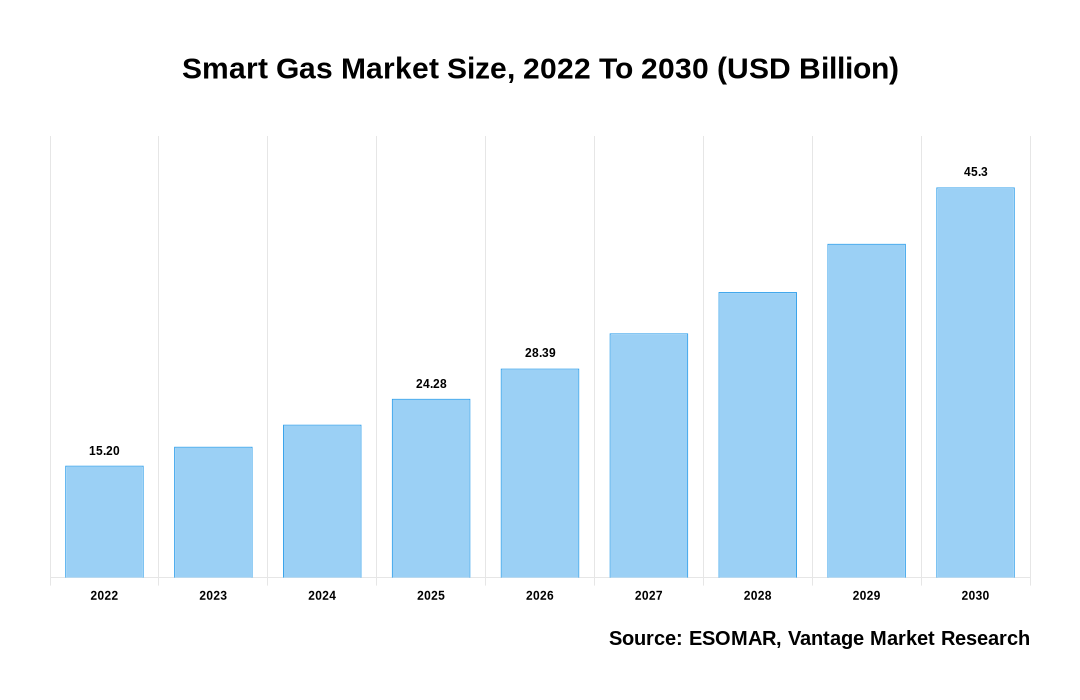Global Smart Gas Market
As stated in our extensive report, the Global Smart Gas Market accounted for USD 15.2 Billion in 2022 and is projected to reach a value of USD 45.3 Billion by 2030.
The Smart Gas market is for advanced technologies and solutions in the natural gas distribution and consumption sector. These technologies leverage IoT (Internet of Things) and other digital advancements to improve gas distribution networks’ efficiency, safety, and sustainability. Several factors are driving the growth of the Smart Gas market. These include the increasing demand for natural gas as a cleaner and more efficient energy source, more effective monitoring and management of gas infrastructure, and implementing of regulations and policies to reduce carbon emissions.
Smart Gas solutions typically involve using sensors, smart meters, communication networks, and data analytics to collect, analyze, and act upon real-time information about gas distribution and consumption. This allows for better monitoring of gas pipeline networks, improved leak detection, and more accurate billing and usage information for consumers. The market for Smart Gas solutions is expected to grow significantly in the coming years as governments and utility companies worldwide invest in upgrading their gas infrastructure. This includes the deployment of smart meters and other devices, as well as the development of advanced analytics and management software.
Click To Get a Free Sample On the Research Study

These are the primary factors that must be considered to propel the growth of the global Smart Gas market. However, there are also challenges to the adoption of Smart Gas technologies. These include high initial costs of implementing infrastructure, data security and privacy concerns, and the need for regulatory frameworks to govern Smart Gas technologies.
Key factors influencing Smart Gas Market Growth
The growth of the global Smart Gas market can be attributable to the following:
- The growing need for efficient and reliable energy infrastructure is driving the adoption of Smart Gas technologies. Smart Gas meters and sensors enable real-time monitoring and control of gas consumption, helping utilities optimize supply and scheduling and improve overall system efficiency.
- Governments and regulatory bodies are increasingly promoting adopting Smart Gas technologies to reduce energy consumption and promote environmental sustainability. For example, several countries have implemented smart metering policies that require utilities to install Smart Gas meters in residential and commercial buildings.
- The increasing focus on environmental sustainability and reducing greenhouse gas emissions is driving the adoption of Smart Gas technologies. Smart Gas solutions enable utilities and consumers to monitor and manage their gas consumption in real time, leading to more efficient energy use and a reduced carbon footprint.
- Rapid advancements in sensing, communication, and data analytics technologies have significantly enhanced the capabilities of Smart Gas solutions. Advanced sensors and meters provide accurate and real-time data on gas consumption, leakage detection, and pressure management. These technological advancements are driving the growth of the Smart Gas market.
- Governments and utilities are investing significantly in upgrading and expanding gas infrastructure to meet the growing energy demands. Smart Gas technologies are critical in optimizing the usage and distribution of gas resources, enabling utilities to deliver a reliable and cost-effective gas supply.
- Increasing consumer awareness about energy efficiency and rising demand for energy management solutions fuel the adoption of Smart Gas technologies. Smart Gas meters allow consumers to monitor and manage their gas consumption, enabling them to make informed decisions and reduce energy costs.
- Smart Gas solutions are increasingly integrated with other smart technologies, such as smart grids and buildings. This integration enables seamless communication and coordination between energy systems, increasing efficiency and sustainability.
- data analytics and predictive maintenance in Smart Gas solutions are gaining traction. Advanced analytics tools analyze real-time gas consumption data, enabling utilities to detect anomalies, predict maintenance needs, and optimize gas distribution networks.
North America Region to Lead the Market
North America Smart Gas market is getting more significant with maximum market share during the forecast period. One of the key factors driving the growth of the Smart Gas market in North America is the increasing emphasis on energy efficiency and environmental sustainability. Governments and regulatory bodies in the region are promoting adopting Smart Gas technologies to reduce carbon emissions and achieve energy savings. Moreover, the presence of numerous gas processing plants, refineries, and distribution networks in North America further contributes to the region’s dominance in the market. Additionally, North America is witnessing significant investments in digital technologies and the Internet of Things (IoT), crucial components of Smart Gas solutions. These investments are boosting the deployment of advanced metering infrastructure, gas leak detection systems, and remote monitoring and control systems. The region also benefits from a strong presence of key market players, such as Honeywell International Inc., Itron Inc., and Schneider Electric, who are actively involved in research and development activities to enhance the efficiency and reliability of Smart Gas solutions.
Conclusion
The need for increased efficiency and sustainability in gas distribution will lead to market growth, positively influencing the overall Smart Gas market.
Some of the key players in the Global Smart Gas Market include- Siemens AG (Germany), Honeywell International Inc. (U.S.), Itron Inc. (U.S.), EDMI Limited (Singapore), Landis+Gyr AG (Switzerland), ABB Ltd. (Switzerland), Holley Technology Ltd. (China), Secure Meter Ltd. (India), Elster Group GmbH (Germany) and others.
![[Market Research Reports] – Research Google News Blog | VMR.Biz](https://www.vmr.biz/wp-content/uploads/2022/12/logo-removebg-preview.png)











